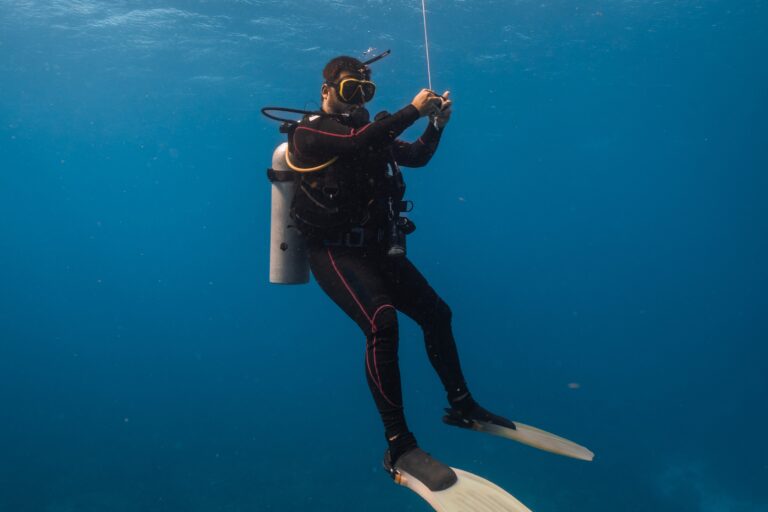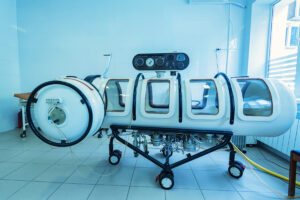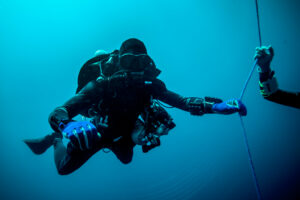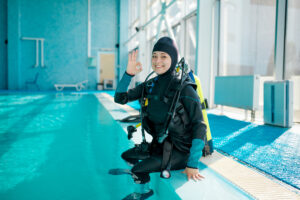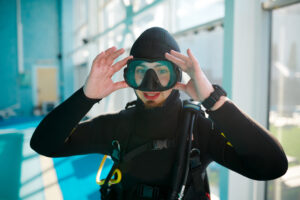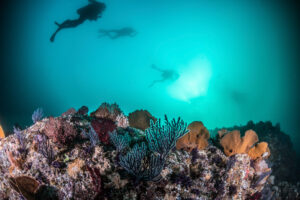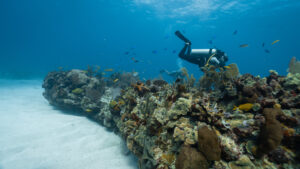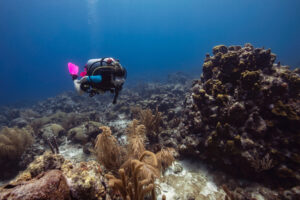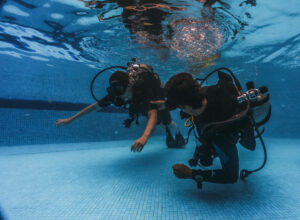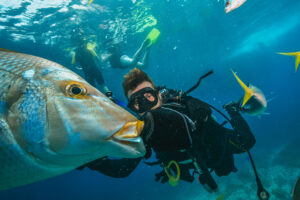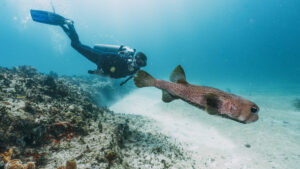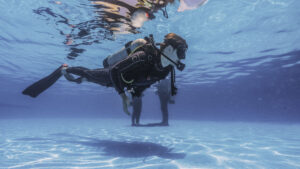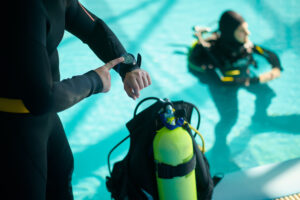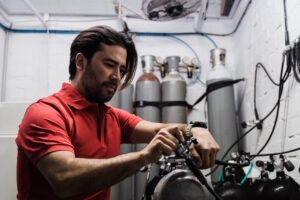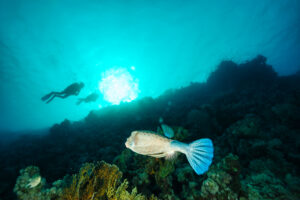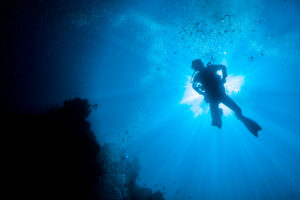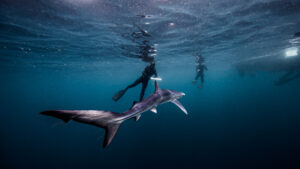What is a Safety Stop during Scuba Diving?
A safety stop is a vital aspect of scuba diving, aimed at minimizing the risk of decompression sickness, commonly known as “the bends.” Decompression sickness occurs when nitrogen bubbles form in a diver’s bloodstream and tissues due to rapid changes in pressure during ascent. Although not required by the decompression schedule, safety stops are a widely recommended practice for divers to enhance their safety underwater.
A safety stop is a voluntary pause during a diver’s ascent, usually lasting around 3 minutes and occurring at a depth of approximately 5 meters (15 feet). The primary purpose of this stop is to allow excess nitrogen, which has dissolved in the body during the dive, to off-gas gradually and safely. By slowing down the ascent and stopping at a shallow depth, divers give their bodies more time to eliminate this excess nitrogen, reducing the risk of decompression sickness.
Decompression Sickness and Nitrogen Off-Gassing
When a diver descends, the increased pressure causes the air in the diving cylinder to become denser. This increased density leads to a higher partial pressure of nitrogen, which dissolves into the diver’s bloodstream and tissues. As the diver ascends and pressure decreases, the dissolved nitrogen comes out of solution and forms tiny bubbles. Rapid ascents can cause these bubbles to form too quickly and in large quantities, leading to decompression sickness.
Decompression sickness can manifest in various ways, such as joint pain, skin rashes, dizziness, and even paralysis or death in severe cases. The safety stop provides an essential buffer for the diver’s body to off-gas nitrogen gradually, reducing the formation of bubbles and the risk of decompression sickness.
Safety Stop Recommendations
The term “safety stop” refers to a practice followed by divers where they pause at a shallow depth toward the end of their dive, allowing accumulated nitrogen in the body to safely off-gas and minimize the risk of decompression sickness, also known as ‘the bends’. Although safety stops are not mandatory in every diving situation, their implementation is considered a best practice across various scenarios, serving as a vital safety measure for divers. safety stops are highly recommended, especially in the following circumstances:
Deep dives
Safety stops are particularly significant following deep dives, those that exceed 18 meters (or roughly 60 feet) in depth. At these depths, divers are subjected to increased pressure that results in a higher degree of nitrogen absorption in the body’s tissues. This increases the likelihood of decompression sickness, an effect that can be mitigated by performing a safety stop to facilitate a slow and controlled release of the nitrogen absorbed.
Long dives
Similarly, safety stops are advisable after long dives. Even dives undertaken at relatively shallow depths can lead to considerable nitrogen buildup if sustained for extended periods. By performing a safety stop following a long dive, divers enhance their safety by allowing for the off-gassing of this accumulated nitrogen in a controlled manner.
Cold water dives
The necessity for safety stops also extends to cold water dives. The low temperatures experienced in such environments can cause constriction of blood vessels in the body, a physiological response that can potentially slow the process of off-gassing. Consequently, the performance of a safety stop in these conditions becomes an essential step to mitigate the risk of decompression sickness.
Multilevel dives
Safety stops are beneficial during multilevel dives as well. These dives involve spending time at different depths, making it more complex to accurately gauge nitrogen absorption levels. The incorporation of a safety stop during such dives provides a cushion against any potential miscalculations in nitrogen absorption and release.
Multiple dives in a day
If a diver is planning multiple dives within a single day, safety stops become even more crucial. In such instances, the body may not have sufficient time to completely off-gas the nitrogen accumulated from one dive before embarking on the next. Performing a safety stop can significantly alleviate this risk.
Dives with decompression stops
Lastly, for dives that necessitate mandatory decompression stops, an additional safety stop at the culmination of the decompression schedule is highly recommended. This acts as an extra layer of protection, ensuring a safe and gradual release of any remaining nitrogen, thereby further reducing the risk of decompression sickness.
Techniques for Performing a Safety Stop
To ensure a successful safety stop, divers should adhere to the following guidelines:
- Use a dive computer or timing device to monitor the duration of the safety stop.
- Maintain a constant depth of approximately 5 meters (15 feet) during the stop. Divers can use a depth gauge, dive computer, or reference line to achieve this.
- Establish neutral buoyancy to avoid unnecessary exertion and maintain a stable position in the water.
- Keep an eye on your surroundings, especially in areas with boat traffic or strong currents.
- Monitor your air supply and never exceed the limits of your remaining air.
- Ascend slowly from the safety stop to the surface, maintaining a rate of no more than 18 meters (60 feet) per minute. This controlled ascent further reduces the risk of decompression sickness by allowing additional off-gassing.
- Always dive with a buddy or within a group, and communicate your plan to perform a safety stop before entering the water. This ensures that everyone is aware of your intentions and can provide assistance if necessary.
- Practice safety stop procedures during dive training to become comfortable with the process and increase the likelihood of performing them routinely during dives.
- Consider using visual aids, such as a safety sausage or surface marker buoy, to alert surface support and boat traffic of your location during the safety stop.
- In the event of an emergency or unexpected situation, prioritize personal safety and abort the safety stop if required. Always remember that safety stops are a precautionary measure, and the safety of the diver should be the primary concern.
Additional Safety Considerations
While safety stops are an essential aspect of safe diving practices, they are not a guarantee against decompression sickness. Divers should also consider the following additional safety measures:
Proper dive planning
A cornerstone of safe diving, regardless of location, is diligent and thorough dive planning. This involves the careful calculation and adherence to a specified dive profile that accounts for depth, duration, and surface intervals. These variables collectively influence the risk of decompression sickness. Moreover, dive planning for cavern diving extends beyond these basics to incorporate other critical elements, such as gas management, emergency procedures, and escape routes. This is to ensure that in case of unexpected incidents, divers are well-equipped to manage the situation.
Nitrox use
The utilization of enriched air nitrox (EAN), a gas blend with a higher concentration of oxygen and a lower percentage of nitrogen than regular air, can significantly enhance diving safety. Due to its composition, it can mitigate nitrogen absorption in the body’s tissues, thereby decreasing the risk of decompression sickness. It is essential, however, to note that EAN use is not without its hazards. Therefore, any diver intending to use nitrox must first acquire the proper certification and training. This will ensure that divers understand the risks associated with oxygen toxicity and are able to properly manage their maximum operating depth (MOD).
Hydration
Maintaining appropriate hydration levels before, during, and after a dive is often overlooked but crucial in mitigating the risk of decompression sickness. Proper hydration facilitates the effective off-gassing process by improving blood circulation and aiding in the efficient removal of nitrogen from the body’s tissues. Divers should be mindful to avoid diuretics such as caffeine and alcohol, which can increase the risk of dehydration.
Adequate rest
Rest plays a crucial role in the body’s recovery process post-dive. Ensuring ample rest intervals between dives allows the body to off-gas residual nitrogen effectively, minimizing the risk of decompression sickness. Equally important is to avoid vigorous physical exertion before and after diving. Such activity can potentially increase metabolic rates, thus boosting nitrogen uptake and hindering its elimination.
Gradual ascents
Rapid ascents are one of the main causes of decompression sickness, thus underlining the importance of slow and controlled ascents. This principle should be adhered to throughout the entire dive and not just confined to the safety stop. Gradual ascents allow dissolved gases in the body enough time to safely off-gas, thereby minimizing the chances of bubble formation that leads to decompression sickness.
Diver health
Physical fitness and overall health can significantly influence a diver’s susceptibility to decompression sickness. Regular exercise, a balanced diet, and avoiding harmful habits like smoking can improve a diver’s physiological response to diving stresses. Furthermore, individuals with specific medical conditions or health concerns that might augment the risk of decompression sickness should seek medical clearance before diving. It is essential for divers to remember that diving is a physically demanding activity that places unique stresses on the body. Maintaining a high level of fitness and overall health is a key part of diving safely.
A safety stop is a crucial component of responsible scuba diving practices, offering divers a practical means to reduce the risk of decompression sickness. By incorporating safety stops into their diving routines and following additional safety measures, divers can enjoy the underwater world with greater confidence and security. Remember that safety should always be the top priority for any diver, and performing safety stops is a significant step towards ensuring a successful and enjoyable diving experience.

